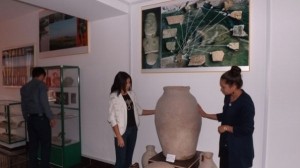SHYMKENT – An exhibition centre housing artefacts from archaeological sites in the region, including important early written texts, has been opened at the South Kazakhstan State Pedagogical Institute.
 The new permanent exhibition aims to promote the history and cultural heritage of the Kazakhs among the public and visitors to the city as well as students. It presents information and artefacts from the tribes that have inhabited the region from the Bronze Age to the state of Karakhanid, which was active until the 13th century. The relics of the region’s history have been collected over 50 years of annual field seasons organised by the archaeological unit of the Faculty of History of the Shymkent Pedagogical Institute. Nikolai Podushkin founded the archaeological team; his son, Professor Alexander Podushkin, now continues his activity.
The new permanent exhibition aims to promote the history and cultural heritage of the Kazakhs among the public and visitors to the city as well as students. It presents information and artefacts from the tribes that have inhabited the region from the Bronze Age to the state of Karakhanid, which was active until the 13th century. The relics of the region’s history have been collected over 50 years of annual field seasons organised by the archaeological unit of the Faculty of History of the Shymkent Pedagogical Institute. Nikolai Podushkin founded the archaeological team; his son, Professor Alexander Podushkin, now continues his activity.
“The findings gathered in the exhibition centre are a good example of the high level of material and spiritual development of the Kazakhs,” said Podushkin. “Thanks to the work of archaeologists, we are learning about the culture of our ancestors, especially nomads, who, wandering, have not left monumental buildings. The artefacts allow us to show the world the achievements of nomadic culture. This was emphasised by the head of state in his speech about the past, present and future of our country.”
The discoveries have allowed archaeologists to determine that the Kangyui state existed only in the south of Kazakhstan, and it was born before the current era. Clay tablets in the Kangyui script are the key exhibits of the centre. Objects related to the written culture of the Kultobe settlement in South Kazakhstan have aroused the interest of museums around the world, and led to Podushkin being invited to the National Academy of France. He has also presented papers to the British Museum.
Podushkin’s finds are the oldest written records to be found in Kazakhstan. Professor Nicholas Sims-Williams of the School of Oriental and African Studies at the University of London helped decipher the inscriptions. The texts are very important and valuable for historians, ethnologists, linguists, archaeologists and cultural specialists of Central Asia, engaged in researching the least studied period in the history of these regions: the first centuries of our era.
“The decrypted script has unique information that allows us to learn about many events. … . The significance of this is enormous: it is autochthonous; i.e. the Kangyuis were writing about themselves. It is also called the Imperial Aramaic script. Fully read, the texts of Kultobe will not only broaden, deepen or clarify some of the pages of the history of ancient states and regions, but will also help change or overwrite them. The scripts in the context of international tourism could be another historic brand for our country, along with such monuments of archaeology and architecture as Otrar and the Turkestan mausoleum. And in the future, a national park devoted to ancient writing can be created,” Podushkin said.
